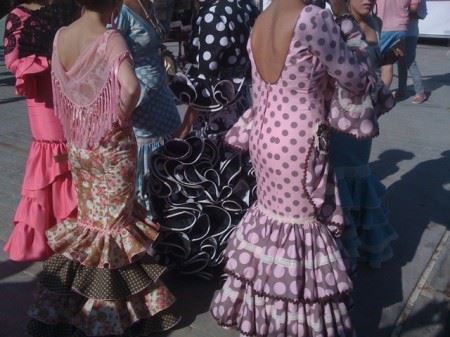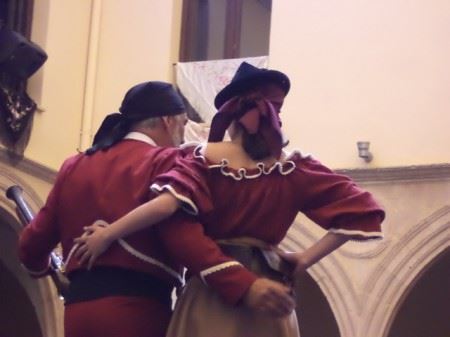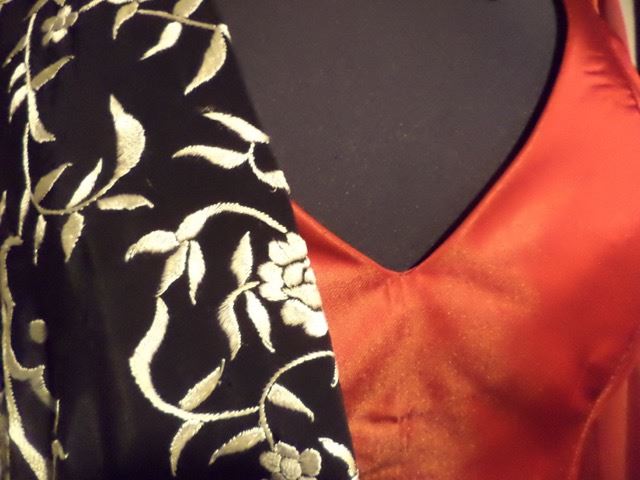
I have long wanted to write something about the Andalucian way of dressing. Not from a well-informed latest fashion point of view, but more from an anthropological, popular culture, street-watching kind of viewpoint. In other words deeply subjective, possibly stereotyping, certainly not in the least bit scientific.
 For someone who spent years on the Canadian West Coast where yoga gear is the going style and fashion usually means ‘practical meets wholesome’, coming to Andalucía was a welcome change. Not only are the clothing and accessories notably more colourful, but people’s body image and ways of carrying their garbs are also quite distinct. The North American general opinion seems to be that young and thin is desirable and beautiful and anything a bit curvaceous, wrinkled or otherwise shaped is shameful. By contrast, I immediately noticed that Southern Spaniards wear their clothes with a certain pride and ease, regardless of size and shape. Not to say that there aren’t problems with body image here as well, but on the whole people seem happy in their own skin. They do not hide themselves, even if they are not magazine perfect, which makes them all the more beautiful to me.
For someone who spent years on the Canadian West Coast where yoga gear is the going style and fashion usually means ‘practical meets wholesome’, coming to Andalucía was a welcome change. Not only are the clothing and accessories notably more colourful, but people’s body image and ways of carrying their garbs are also quite distinct. The North American general opinion seems to be that young and thin is desirable and beautiful and anything a bit curvaceous, wrinkled or otherwise shaped is shameful. By contrast, I immediately noticed that Southern Spaniards wear their clothes with a certain pride and ease, regardless of size and shape. Not to say that there aren’t problems with body image here as well, but on the whole people seem happy in their own skin. They do not hide themselves, even if they are not magazine perfect, which makes them all the more beautiful to me.

This seeming self-contentment may be something to do with the Latin mind set, their abundance of sunlight or even their brocade and gold clothed madonnas and virgins. Just as their music and art are generally more colourful than the one we have further north, so is their fashion. Just think about the Spanish clothing companies like Desigual andCusto (not to be confused by Cosco…) or the clothing line of the descendant of Miró.
Anyhow, back to rural fashion. Watching a family coming out from a christening or a first communion dressed in all their finery is a veritable feast to the eye. Of course, as Ronda is a small town (not much more than a large village, really), we are not talking latest runway fashion. But around here this does not matter (and who the hell cares anyhow?). What matters is that it is colourful and festive.
One cannot speak about Spanish street wear without mentioning the heels, as in the pointy thing at the back of a shoe. We have friends here whom I have never seen without a pair of high heels, even if they are doing garden work. In fact, we have neighbours who leap straight out of their bed and into their stilettos. I have not seen them, but I have certainly heard them. Andalucian women embrace their femininity, which to some equals wearing a minimum 8 cm heel. Some twin sisters on our street started stealing their mother’s high-heeled shoes shortly after starting to walk. Now they have been given their very own pairs. Consider it like training wheels on a bicycle, something that has to be taught. It is a cultural phenomenon, like any other.

I love the fact that Spanish men can embrace their pink side and wear a bubble gum coloured shirt, a purple tie, a silky neck scarf or a pair of pistachio pants without feeling that this in any way affects their manliness. I love the way the Andalucian women dress up for almost any occasion, even to go to the store. Compared to us foreigners, they are almost always lovely put together. The locals claim they recognize the foreigners by their shoes. On Ronda’s famous bridge any given morning one can pick out the guiris by their tell-tale choice of foot ware – runners, Birkenstocks or flip flops, the latter which any self respecting Spanish women would not be caught dead in. Spanish women on the other hand will usually have matching outfit, shoes and handbag, their hair in a lovely coif, with perfect nails and makeup, like they were going to an audition, not to the bank tellers.
Their rural Andalucian fiesta attire, the style sometimes dare I say a bit ‘sluttish’ for my protestant upbringing, and the fabric at times without a single natural fibre, is not so important as the generalva-va-voom effect. Sequence, large gilded embroideries, plunging backsides, straps studded with ‘diamonds’ and peekaboo holes in expected and unexpected places are all good. Though it might seem like I am finding their style in poor taste, it is not so. The women of Andalucía can carry off almost anything, paired with a bright lipstick and a long shiny black mane, fiercely straightened to get out every sign of a wave, or god forbid those stunning black curls…

And did I mention the jewellery? I have never seen earrings like the ones here in Andalucía. Women wear enormous pendants, fake and real, plastic, crystal, precious stones and sheer gold, interwoven with lace and the finest needlework. But it doesn’t stop there. There are rings and then there are Spanish rings. Large rocks upon every finger, usually several to one. A friend in our barrio wears necklaces so big that one day when she had a possibly real coral number around her neck we wondered whether she there was anything left of the Great Barrier Reef. Older Andalucian women seem to avoid the granny style, either wearing impeccable suits and neck scarves, or going to the other end of the spectrum, flamboyant colours, fake fur and massive BLING. I remember watching a handful octogenians having summer night cocktails in a plaza in Malaga, just dripping in gaudy jewellery and looking just fabulous.
 When it comes to their offspring, the outfits are a whole different story. While North America and Northern Europe families generally goes the Baby Gap/H&M cute, but practical route, the Spanish goes Victorian. Families take deep pride in swaddling their babies in the most impeccable hand embroidered linens and beautiful subtle lace. As the baby grows into a toddler they will be clothed in Laura Ashley style dresses or Little Lord Fauntleroy shorts, patent leather shoes and matching stockings, usually with tassels. In the winter, the children will have classic woollen coats, with complementing crochet hats, mitts and stockings. If mom is with them she may sport a matching outfit, while the boys often echo their father’s choice in dress shirt. It is mini-me all the way. I would have never managed to dress my son in the fashion without loud protestations. In fact, I believe he still is working on forgiving me for dressing him in a vintage suit and baby cowboy boots when we lived in LA and he was two…
When it comes to their offspring, the outfits are a whole different story. While North America and Northern Europe families generally goes the Baby Gap/H&M cute, but practical route, the Spanish goes Victorian. Families take deep pride in swaddling their babies in the most impeccable hand embroidered linens and beautiful subtle lace. As the baby grows into a toddler they will be clothed in Laura Ashley style dresses or Little Lord Fauntleroy shorts, patent leather shoes and matching stockings, usually with tassels. In the winter, the children will have classic woollen coats, with complementing crochet hats, mitts and stockings. If mom is with them she may sport a matching outfit, while the boys often echo their father’s choice in dress shirt. It is mini-me all the way. I would have never managed to dress my son in the fashion without loud protestations. In fact, I believe he still is working on forgiving me for dressing him in a vintage suit and baby cowboy boots when we lived in LA and he was two…
 Ronda’s fiesta fashion depends on the season and is closely tied to the town’s history, art and culture. Southern Spain is where Flamenco music and dance started and it is still very much part of our society here, especially during the local ferias. The colours, patterns and combinations may be flamboyant or exuberant, but they are always gay and festive. I used to think that flamenco dresses was just for tourists and postcards (Remember the cards people used to send from Spain in the 1970′s with the fabric dresses that one could lift up?). However, most women we know here in Ronda have at least a couple of flamenco dresses in the cupboard, if not half a dozen. They also dance a mean Sevillana!
Ronda’s fiesta fashion depends on the season and is closely tied to the town’s history, art and culture. Southern Spain is where Flamenco music and dance started and it is still very much part of our society here, especially during the local ferias. The colours, patterns and combinations may be flamboyant or exuberant, but they are always gay and festive. I used to think that flamenco dresses was just for tourists and postcards (Remember the cards people used to send from Spain in the 1970′s with the fabric dresses that one could lift up?). However, most women we know here in Ronda have at least a couple of flamenco dresses in the cupboard, if not half a dozen. They also dance a mean Sevillana!
 The style of the infamous 18th and 19thcentury robbers in the Serranía de Rondais now used in folkloric fiestas and adapted into popular fashion. During the month of May when our town celebrates Ronda Romantico, locals walk through town dressed like Bandoleros and Bandolareas.Others dress in the more urban, elaborate,Goyesque fashion, influenced by the paintings of Spanish painter Francisco José de Goya (1746-1828)
The style of the infamous 18th and 19thcentury robbers in the Serranía de Rondais now used in folkloric fiestas and adapted into popular fashion. During the month of May when our town celebrates Ronda Romantico, locals walk through town dressed like Bandoleros and Bandolareas.Others dress in the more urban, elaborate,Goyesque fashion, influenced by the paintings of Spanish painter Francisco José de Goya (1746-1828)
 Since Ronda is still very much an equestrian society, rondeños often have the rider look (all but the whip) in winter. Whether they are going drinking or to the office, they will wear quasi-jodhpurs, tall well polished riding boots and stylishly tight-fitting jackets with bright-coloured piping.
Since Ronda is still very much an equestrian society, rondeños often have the rider look (all but the whip) in winter. Whether they are going drinking or to the office, they will wear quasi-jodhpurs, tall well polished riding boots and stylishly tight-fitting jackets with bright-coloured piping.
Finally, bull fighting has of course also been adapted into Spanish fashion. As recent as last year international designers Dolce & Gabbana launched a wholeTauromanía fashion line. Whether one likes bull fighting or not, the matador (killer) fashion is always in vogue in Spain, particularly here in the south.
After three years I have become a local of sorts, but I cannot escape having a cara de guiri (a face of a foreigner). I have brought a few strappy high-heeled sandals and will wear them in the summer, but I still wear my Norwegian rain boots, my trail runners and, on occasion, even the dreaded flip-flops! Yet moving to Ronda, I could bring out things I could never even dream of wearing in Canada. Andalucía is a place to embrace your femininity – or your pink masculinity for that matter. Nothing is too big, too bright or too tight. It is all about colours. Art imitating life, joy, blood and even death.
